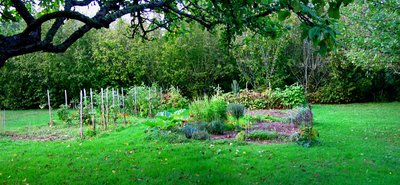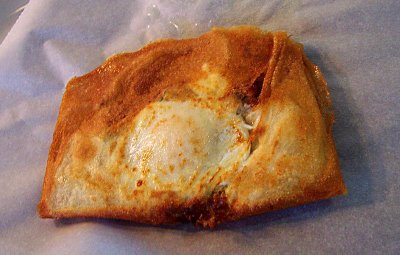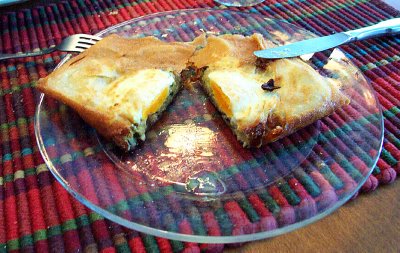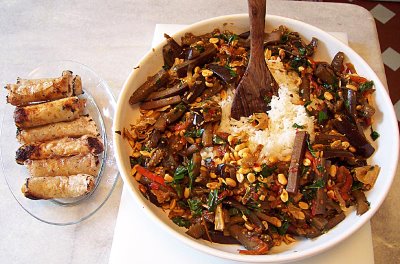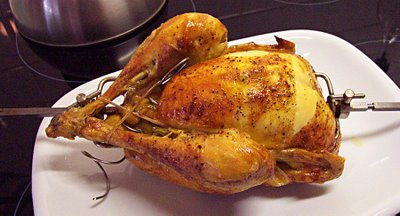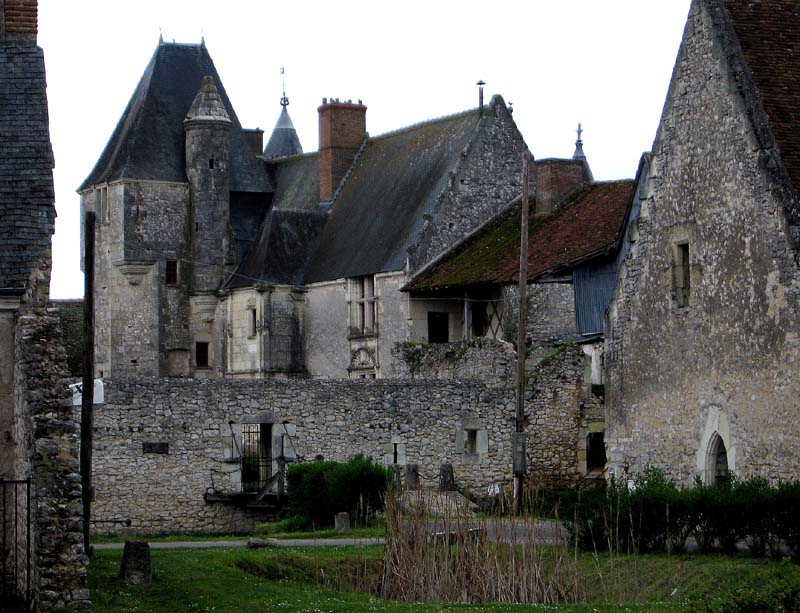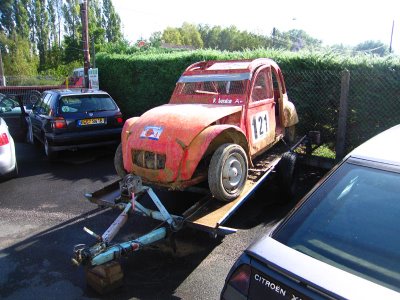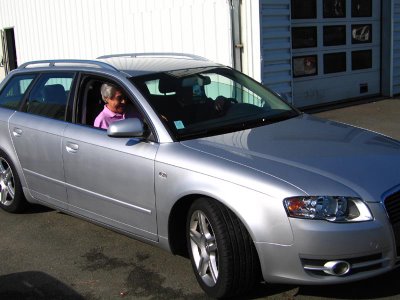Next Thursday we will be on a plane flying from Paris to New York City.
This will be my second trip back to the U.S. since the summer of 2003, and Walt's too.
Since we don't have poor old Collette the dog any more, we can travel together. Nobody needs to stay here to take care of Collette any more. We are going to spend a month in the eastern U.S., arriving in NYC and flying back out from Chicago to Paris in November.
English friends of ours will be taking care of our house. It's nice to have the house occupied while we are away.
It will be fun to drive around in a rental car through NY, NJ, DE, MD, VA, NC, SC, GA, AL, TN, KY, IN, and IL. Will we be able to tell the difference between the different states? Everything is so the same in the U.S. nowadays. NC is beginning to look a lot like CA, from what I hear and read.
We will miss October in the Loire Valley. It's a beautiful time of year. Last year it was warm right up until the end of October. But you never know, it could also be chilly and rainy while we are gone.
We'll be spending part of our time in upstate New York and part in coastal North Carolina, with stops and side trips to Washington DC and Atlanta GA.
I plan to continue blogging as we travel around. I'm taking my camera.
30 September 2006
29 September 2006
St-Benoît-sur-Loire
Philippe 1er of France was born in the year 1052 and was crowned king in 1060, when he was eight years old. His mother served as his regent for the first seven or eight years of his reign. We know him in English as Philip the First. Philippe was not a common name in France at the time, evidently — Philippe's mother was Anne de Kiev, a Ukrainian.
Le roi Philippe remained on the throne of France until his death in 1108 — a 48-year reign. He was the great-grandson of Hugues Capet, who as king of France from 987 to 996 was the founder of the Capetian dynasty. The last direct descendant of Charlemagne had failed to produce a male heir. Hugues Capet was elected king by an assembly of French noblemen.
Philippe 1er spent most of his long reign trying to keep his unruly vassals — the dukes and other noblemen who controlled one piece or other of territory around Paris — in line. He succeeded at least to an extent, because his descendants continued to rule France until 1328.
One of Philippe's vassals, the Duke of Normandy that the world came to call William the Conqueror, won the battle of Hastings and became king of England when Philippe had been king of France for just six years (and was 14 years old). Philippe and William (Guillaume, in French) made peace ten years later, when William promised he would quit trying to extend his realm by conquering Brittany. Evidently, Philippe spent years trying to provoke unrest and dissension within the Anglo-Norman kingdom as a way to reduce its threat to his own power.
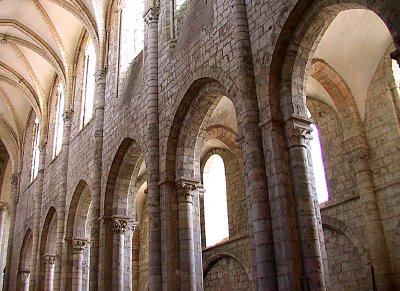 When he was 20, Philippe was married to Bertha of Holland, and they had five children. Then in 1092, at the age of 40, he fell in love with Bertrade de Montfort. He repudiated Bertha. He married Bertrade and was excommunicated by Pope Urban II.
When he was 20, Philippe was married to Bertha of Holland, and they had five children. Then in 1092, at the age of 40, he fell in love with Bertrade de Montfort. He repudiated Bertha. He married Bertrade and was excommunicated by Pope Urban II.
His excommunication prevented Philip from taking part in the First Crusade, which was launched in 1095 and which he didn't personally support because of his conflict with the papacy.
 When Philip died in 1108 at the château of Melun, near Paris, his body was carried in a great procession from there to the abbey church at St-Benoît-sur-Loire, some 70 miles distant, where he wished to be buried.
When Philip died in 1108 at the château of Melun, near Paris, his body was carried in a great procession from there to the abbey church at St-Benoît-sur-Loire, some 70 miles distant, where he wished to be buried.
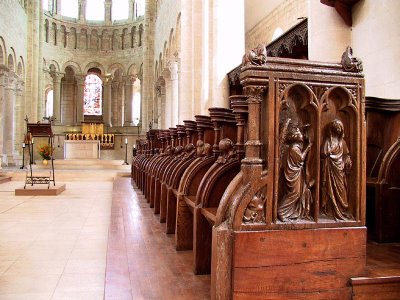 The monastery at what is now called St-Benoît-sur-Loire had been founded four or five hundred years earlier. It was called Fleury then. In the late 600s, a group of monks from Fleury made the long trek to southern Italy and brought back some of the remains of St. Benedict (Benoît is French for Benedict). The bones that they found and carried back were certified as authentic by the pope at the time.
The monastery at what is now called St-Benoît-sur-Loire had been founded four or five hundred years earlier. It was called Fleury then. In the late 600s, a group of monks from Fleury made the long trek to southern Italy and brought back some of the remains of St. Benedict (Benoît is French for Benedict). The bones that they found and carried back were certified as authentic by the pope at the time.
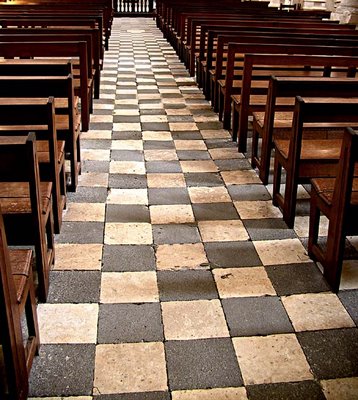 St-Benoît-sur-Loire became a very holy place in Christendom, given Benedict's stature as the founder of the great religious order that carries his name, the Benedictines. The saint's remains, or relics, according to the Michelin guide, were a "source of miracles, of healing, and many wonders that couldn't but draw crowds and spread the fame of the place from then on known as St-Benoît."
St-Benoît-sur-Loire became a very holy place in Christendom, given Benedict's stature as the founder of the great religious order that carries his name, the Benedictines. The saint's remains, or relics, according to the Michelin guide, were a "source of miracles, of healing, and many wonders that couldn't but draw crowds and spread the fame of the place from then on known as St-Benoît."
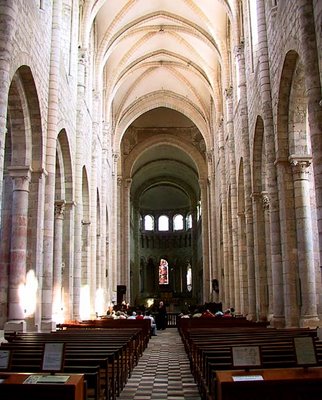 CHM and I visited the church at St-Benoît on July 15, 2006, and that's when these pictures of the interior of the church were taken. Earlier in the day, we had been at Yèvre, Bellegarde, and Sully, where there are impressive châteaux. We arrived at St-Benoît just ahead of a busload of teenagers in a school group. Restoration work was going on at the church, so parts of the building that we wanted to see were closed to the public. And it was crowded with tourists.
CHM and I visited the church at St-Benoît on July 15, 2006, and that's when these pictures of the interior of the church were taken. Earlier in the day, we had been at Yèvre, Bellegarde, and Sully, where there are impressive châteaux. We arrived at St-Benoît just ahead of a busload of teenagers in a school group. Restoration work was going on at the church, so parts of the building that we wanted to see were closed to the public. And it was crowded with tourists.
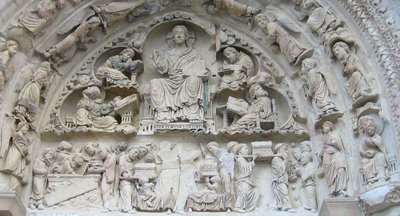 The great church at St-Benoît stands on the banks of the Loire just a few miles from Sully, in an area called Le Val d'Or — the Valley of Gold. The building that exists today was built mostly around the time of Philippe Ier, in the 11th and 12th centuries. Of the earlier monastic buildings, nothing remains.
The great church at St-Benoît stands on the banks of the Loire just a few miles from Sully, in an area called Le Val d'Or — the Valley of Gold. The building that exists today was built mostly around the time of Philippe Ier, in the 11th and 12th centuries. Of the earlier monastic buildings, nothing remains.
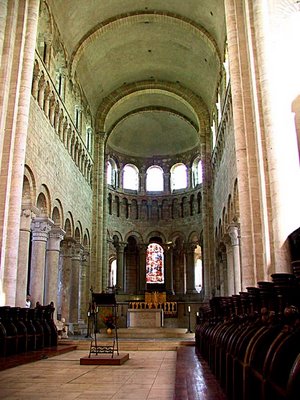 The Michelin guide describes the church this way: "A dazzling example of art and spirituality, St-Benoît is enthralling for the simple grandeur of its proportions, the delicate riches of its sculptures, and the soft golden light that seems to drape its vaults and columns." St-Benoît-sur-Loire was a great center of learning and scholarship in the 10th, 11th, and 12th centuries.
The Michelin guide describes the church this way: "A dazzling example of art and spirituality, St-Benoît is enthralling for the simple grandeur of its proportions, the delicate riches of its sculptures, and the soft golden light that seems to drape its vaults and columns." St-Benoît-sur-Loire was a great center of learning and scholarship in the 10th, 11th, and 12th centuries.
 The monastery went into decline in the 15th century. The French kings gave it over to hired abbots, some of whom were laymen with no religious mission or education. In the early 16th century, the monks revolted against King François 1er's appointee, and the king had to go in person to St-Benoît with an army to put down the rebellion.
The monastery went into decline in the 15th century. The French kings gave it over to hired abbots, some of whom were laymen with no religious mission or education. In the early 16th century, the monks revolted against King François 1er's appointee, and the king had to go in person to St-Benoît with an army to put down the rebellion.
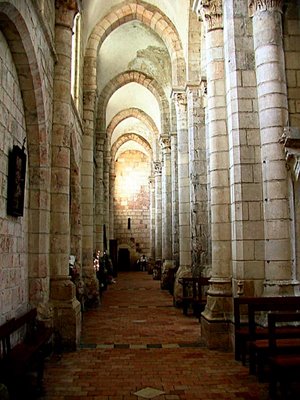 In the second half of the 16th century, during the wars of religion pitting catholics against protestants, one of the abbots of St-Benoît converted to protestantism. He let the protestant forces pillage the monastery and melt down its gold treasures, including the 35-pound reliquary that held St-Benoît's supposed remains. The library was sold off, including some 2000 manuscripts that ended up dispersed all over Europe.
In the second half of the 16th century, during the wars of religion pitting catholics against protestants, one of the abbots of St-Benoît converted to protestantism. He let the protestant forces pillage the monastery and melt down its gold treasures, including the 35-pound reliquary that held St-Benoît's supposed remains. The library was sold off, including some 2000 manuscripts that ended up dispersed all over Europe.
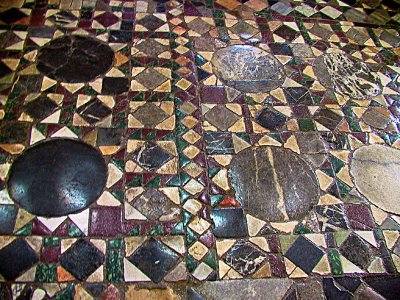 You might have noticed the elaborate tile floor upon which Philippe 1er's tomb effigy rests. One source describes it as an Italian mosaic that was completed in 1531. Another calls it a "Byzantine mosaics floor." It is one of the church's extraordinary features.
You might have noticed the elaborate tile floor upon which Philippe 1er's tomb effigy rests. One source describes it as an Italian mosaic that was completed in 1531. Another calls it a "Byzantine mosaics floor." It is one of the church's extraordinary features.
Le roi Philippe remained on the throne of France until his death in 1108 — a 48-year reign. He was the great-grandson of Hugues Capet, who as king of France from 987 to 996 was the founder of the Capetian dynasty. The last direct descendant of Charlemagne had failed to produce a male heir. Hugues Capet was elected king by an assembly of French noblemen.
Philippe 1er spent most of his long reign trying to keep his unruly vassals — the dukes and other noblemen who controlled one piece or other of territory around Paris — in line. He succeeded at least to an extent, because his descendants continued to rule France until 1328.
One of Philippe's vassals, the Duke of Normandy that the world came to call William the Conqueror, won the battle of Hastings and became king of England when Philippe had been king of France for just six years (and was 14 years old). Philippe and William (Guillaume, in French) made peace ten years later, when William promised he would quit trying to extend his realm by conquering Brittany. Evidently, Philippe spent years trying to provoke unrest and dissension within the Anglo-Norman kingdom as a way to reduce its threat to his own power.
 When he was 20, Philippe was married to Bertha of Holland, and they had five children. Then in 1092, at the age of 40, he fell in love with Bertrade de Montfort. He repudiated Bertha. He married Bertrade and was excommunicated by Pope Urban II.
When he was 20, Philippe was married to Bertha of Holland, and they had five children. Then in 1092, at the age of 40, he fell in love with Bertrade de Montfort. He repudiated Bertha. He married Bertrade and was excommunicated by Pope Urban II.His excommunication prevented Philip from taking part in the First Crusade, which was launched in 1095 and which he didn't personally support because of his conflict with the papacy.
 When Philip died in 1108 at the château of Melun, near Paris, his body was carried in a great procession from there to the abbey church at St-Benoît-sur-Loire, some 70 miles distant, where he wished to be buried.
When Philip died in 1108 at the château of Melun, near Paris, his body was carried in a great procession from there to the abbey church at St-Benoît-sur-Loire, some 70 miles distant, where he wished to be buried. The monastery at what is now called St-Benoît-sur-Loire had been founded four or five hundred years earlier. It was called Fleury then. In the late 600s, a group of monks from Fleury made the long trek to southern Italy and brought back some of the remains of St. Benedict (Benoît is French for Benedict). The bones that they found and carried back were certified as authentic by the pope at the time.
The monastery at what is now called St-Benoît-sur-Loire had been founded four or five hundred years earlier. It was called Fleury then. In the late 600s, a group of monks from Fleury made the long trek to southern Italy and brought back some of the remains of St. Benedict (Benoît is French for Benedict). The bones that they found and carried back were certified as authentic by the pope at the time. St-Benoît-sur-Loire became a very holy place in Christendom, given Benedict's stature as the founder of the great religious order that carries his name, the Benedictines. The saint's remains, or relics, according to the Michelin guide, were a "source of miracles, of healing, and many wonders that couldn't but draw crowds and spread the fame of the place from then on known as St-Benoît."
St-Benoît-sur-Loire became a very holy place in Christendom, given Benedict's stature as the founder of the great religious order that carries his name, the Benedictines. The saint's remains, or relics, according to the Michelin guide, were a "source of miracles, of healing, and many wonders that couldn't but draw crowds and spread the fame of the place from then on known as St-Benoît." CHM and I visited the church at St-Benoît on July 15, 2006, and that's when these pictures of the interior of the church were taken. Earlier in the day, we had been at Yèvre, Bellegarde, and Sully, where there are impressive châteaux. We arrived at St-Benoît just ahead of a busload of teenagers in a school group. Restoration work was going on at the church, so parts of the building that we wanted to see were closed to the public. And it was crowded with tourists.
CHM and I visited the church at St-Benoît on July 15, 2006, and that's when these pictures of the interior of the church were taken. Earlier in the day, we had been at Yèvre, Bellegarde, and Sully, where there are impressive châteaux. We arrived at St-Benoît just ahead of a busload of teenagers in a school group. Restoration work was going on at the church, so parts of the building that we wanted to see were closed to the public. And it was crowded with tourists. The great church at St-Benoît stands on the banks of the Loire just a few miles from Sully, in an area called Le Val d'Or — the Valley of Gold. The building that exists today was built mostly around the time of Philippe Ier, in the 11th and 12th centuries. Of the earlier monastic buildings, nothing remains.
The great church at St-Benoît stands on the banks of the Loire just a few miles from Sully, in an area called Le Val d'Or — the Valley of Gold. The building that exists today was built mostly around the time of Philippe Ier, in the 11th and 12th centuries. Of the earlier monastic buildings, nothing remains. The Michelin guide describes the church this way: "A dazzling example of art and spirituality, St-Benoît is enthralling for the simple grandeur of its proportions, the delicate riches of its sculptures, and the soft golden light that seems to drape its vaults and columns." St-Benoît-sur-Loire was a great center of learning and scholarship in the 10th, 11th, and 12th centuries.
The Michelin guide describes the church this way: "A dazzling example of art and spirituality, St-Benoît is enthralling for the simple grandeur of its proportions, the delicate riches of its sculptures, and the soft golden light that seems to drape its vaults and columns." St-Benoît-sur-Loire was a great center of learning and scholarship in the 10th, 11th, and 12th centuries. The monastery went into decline in the 15th century. The French kings gave it over to hired abbots, some of whom were laymen with no religious mission or education. In the early 16th century, the monks revolted against King François 1er's appointee, and the king had to go in person to St-Benoît with an army to put down the rebellion.
The monastery went into decline in the 15th century. The French kings gave it over to hired abbots, some of whom were laymen with no religious mission or education. In the early 16th century, the monks revolted against King François 1er's appointee, and the king had to go in person to St-Benoît with an army to put down the rebellion. In the second half of the 16th century, during the wars of religion pitting catholics against protestants, one of the abbots of St-Benoît converted to protestantism. He let the protestant forces pillage the monastery and melt down its gold treasures, including the 35-pound reliquary that held St-Benoît's supposed remains. The library was sold off, including some 2000 manuscripts that ended up dispersed all over Europe.
In the second half of the 16th century, during the wars of religion pitting catholics against protestants, one of the abbots of St-Benoît converted to protestantism. He let the protestant forces pillage the monastery and melt down its gold treasures, including the 35-pound reliquary that held St-Benoît's supposed remains. The library was sold off, including some 2000 manuscripts that ended up dispersed all over Europe. You might have noticed the elaborate tile floor upon which Philippe 1er's tomb effigy rests. One source describes it as an Italian mosaic that was completed in 1531. Another calls it a "Byzantine mosaics floor." It is one of the church's extraordinary features.
You might have noticed the elaborate tile floor upon which Philippe 1er's tomb effigy rests. One source describes it as an Italian mosaic that was completed in 1531. Another calls it a "Byzantine mosaics floor." It is one of the church's extraordinary features.
28 September 2006
Tunisian brik à l'œuf
Emily, this one's for you.
If you don't know Emily, have a look at her What's for Lunch? blog. She lives and works in Paris, and during the week she posts photos of her lunches. Then on weekends, she cooks and posts her photo-recipes of dishes like brik à l'œuf and laksa (a great SE Asian soup).
Inspired by Emily's brik à l'œuf posting, I went to Intermarché earlier this week and bought the basic ingredients: some feuilles de brick (or brik — you choose the spelling you like), a can of tuna, and some eggs. I already had onions and capers.
One of the things I like about Intermarché is that it sells tuna in a big can — three times the size of a normal can of tuna — and at a very low price. You can buy a big can of tuna packed in oil or packed in water for about half what you pay, by weight, for the little cans. So that's what I buy. The quality is good. I prefer tuna packed in water. I can drain it and add my own oil.
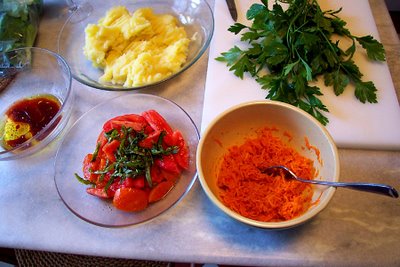 Tomato-basil and grated carrot salads as accompaniments,
Tomato-basil and grated carrot salads as accompaniments,
along with mashed potatoes and a bunch of flat-leaf parsley for the briks
We like tuna and can eat the contents of the giant economy-size can over the course of a few days. I'm making tuna salad with the rest of the tuna this morning, in fact. Tuna salad in French is rillettes de thon — and it is similar, when you think about it, to the potted, shredded meats called rillettes that they make here with duck, goose, pork, or even chicken.
So I bought my tuna and eggs and all at Intermarché and I came home and started looking at brik recipes on the Internet. Emily's recipe called for onions, tuna, capers, lemon juice, and eggs. Read it — you'll see. It looks good.
I found a slightly different recipe, called Brick au thon, that includes mashed potatoes in the filling. I decided to try that, because I wanted the brik to be our main course for lunch, with just some salads on the side.
The first step was to cook four fairly big baking potatoes in a covered dish in the microwave. That took about 20 minutes on medium. When they're done, cut the potatoes in half so they will cool faster.
Meantime, chop an onion or two. Put the diced onion in a pan with a little olive oil and some salt and let it "sweat down" — just to soften it. Put in a glug of white wine or even a pinch of sugar to help the onions along.
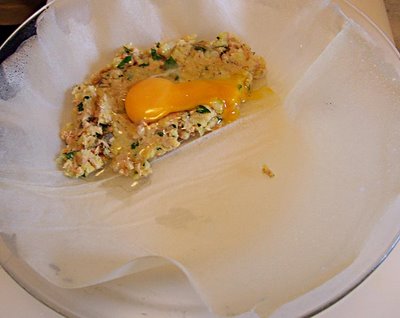 Spread out the sheet of pastry in a big flat bowl or on a flat surface.
Spread out the sheet of pastry in a big flat bowl or on a flat surface.
This is the one where the first egg squirted out when we tried to move
the whole thing to the pan. We added another egg and tried again.
Chop the parsley and mash the potatoes. Combine potato, parsley, onion, and tuna to make a fairly dry mixture you can use as a filling for the sheets of brik. Don't forget salt and pepper, and add other spices or herbs as you like. I added a pinch of the ras-el-hanout spice powder that I like. You could put in a pinch of curry powder. Or not.
Now the fun begins. Spread out a sheet of brik. By the way, I wonder if phyllo would work for this kind of preparation. Here's an interesting web page about brik. (The author of the page is Sue Nelson!) Put a good dollop of the potato filling toward the center of the pastry so that you'll be able to fold the whole thing into a half-moon shape. Make a little depression in the filling and break a raw egg into it. Fold the pastry over it.
Carefully lift the whole filled half-moon of pastry and put it into hot oil in a pan to cook it. When we tried this we didn't think about the fact that the pastry sheets, which had been folded in half in the package they came it, had kind of split down the middle. We lifted up the first one (the picture at the top of this posting) and the raw egg started bulging out through the crack. But we got it to the pan OK. On that one, I folded the edges over to make it into more of a square shape.
When we made the second brik and lifted it to put it in the pan, the egg yolk broke and most of the egg white and yolk squirted out and ended up on the floor and all over the sink next to the stove. We just put it back, put in another egg, and lifted it very very carefully to the pan. It worked the second time, more or less.
Here's what the brik looks like when you're successful and when you eat it. The egg white is cooked but the yolk is runny. It makes the potato-tuna stuffing very moist and is great with the crispy pastry.
Because we were making several briks and we wanted to sit down together at the table to eat them, I put the briks on a baking sheet in a warm oven to hold them while more were cooking. I guess the oven was too hot, or maybe the briks just sat for too long. At any rate, the second one I ate looked like this. The yolk was set.
Over all, the briks were very good, and the potato-tuna filling was, well, quite filling. The turnovers were a little oily though, and making and cooking them was a messy process. We still have some feuilles de brik left, so I guess we'll make some more anyway. Maybe practice will make perfect.
If you don't know Emily, have a look at her What's for Lunch? blog. She lives and works in Paris, and during the week she posts photos of her lunches. Then on weekends, she cooks and posts her photo-recipes of dishes like brik à l'œuf and laksa (a great SE Asian soup).
Inspired by Emily's brik à l'œuf posting, I went to Intermarché earlier this week and bought the basic ingredients: some feuilles de brick (or brik — you choose the spelling you like), a can of tuna, and some eggs. I already had onions and capers.
One of the things I like about Intermarché is that it sells tuna in a big can — three times the size of a normal can of tuna — and at a very low price. You can buy a big can of tuna packed in oil or packed in water for about half what you pay, by weight, for the little cans. So that's what I buy. The quality is good. I prefer tuna packed in water. I can drain it and add my own oil.
 Tomato-basil and grated carrot salads as accompaniments,
Tomato-basil and grated carrot salads as accompaniments,along with mashed potatoes and a bunch of flat-leaf parsley for the briks
We like tuna and can eat the contents of the giant economy-size can over the course of a few days. I'm making tuna salad with the rest of the tuna this morning, in fact. Tuna salad in French is rillettes de thon — and it is similar, when you think about it, to the potted, shredded meats called rillettes that they make here with duck, goose, pork, or even chicken.
So I bought my tuna and eggs and all at Intermarché and I came home and started looking at brik recipes on the Internet. Emily's recipe called for onions, tuna, capers, lemon juice, and eggs. Read it — you'll see. It looks good.
I found a slightly different recipe, called Brick au thon, that includes mashed potatoes in the filling. I decided to try that, because I wanted the brik to be our main course for lunch, with just some salads on the side.
The first step was to cook four fairly big baking potatoes in a covered dish in the microwave. That took about 20 minutes on medium. When they're done, cut the potatoes in half so they will cool faster.
Meantime, chop an onion or two. Put the diced onion in a pan with a little olive oil and some salt and let it "sweat down" — just to soften it. Put in a glug of white wine or even a pinch of sugar to help the onions along.
 Spread out the sheet of pastry in a big flat bowl or on a flat surface.
Spread out the sheet of pastry in a big flat bowl or on a flat surface.This is the one where the first egg squirted out when we tried to move
the whole thing to the pan. We added another egg and tried again.
Chop the parsley and mash the potatoes. Combine potato, parsley, onion, and tuna to make a fairly dry mixture you can use as a filling for the sheets of brik. Don't forget salt and pepper, and add other spices or herbs as you like. I added a pinch of the ras-el-hanout spice powder that I like. You could put in a pinch of curry powder. Or not.
Now the fun begins. Spread out a sheet of brik. By the way, I wonder if phyllo would work for this kind of preparation. Here's an interesting web page about brik. (The author of the page is Sue Nelson!) Put a good dollop of the potato filling toward the center of the pastry so that you'll be able to fold the whole thing into a half-moon shape. Make a little depression in the filling and break a raw egg into it. Fold the pastry over it.
Carefully lift the whole filled half-moon of pastry and put it into hot oil in a pan to cook it. When we tried this we didn't think about the fact that the pastry sheets, which had been folded in half in the package they came it, had kind of split down the middle. We lifted up the first one (the picture at the top of this posting) and the raw egg started bulging out through the crack. But we got it to the pan OK. On that one, I folded the edges over to make it into more of a square shape.
When we made the second brik and lifted it to put it in the pan, the egg yolk broke and most of the egg white and yolk squirted out and ended up on the floor and all over the sink next to the stove. We just put it back, put in another egg, and lifted it very very carefully to the pan. It worked the second time, more or less.
Here's what the brik looks like when you're successful and when you eat it. The egg white is cooked but the yolk is runny. It makes the potato-tuna stuffing very moist and is great with the crispy pastry.
Because we were making several briks and we wanted to sit down together at the table to eat them, I put the briks on a baking sheet in a warm oven to hold them while more were cooking. I guess the oven was too hot, or maybe the briks just sat for too long. At any rate, the second one I ate looked like this. The yolk was set.
Over all, the briks were very good, and the potato-tuna filling was, well, quite filling. The turnovers were a little oily though, and making and cooking them was a messy process. We still have some feuilles de brik left, so I guess we'll make some more anyway. Maybe practice will make perfect.
26 September 2006
It's fall
It's fall now and we are getting great sunsets again. Here's last night's. Click the images to see them at full size.
24 September 2006
Do you cook every day?
How has my life changed since I quit work and moved to France? The two biggest differences are: I don't commute any more, and I cook nearly every day. Some of my (our, really) recent cooking adventures are pictured in this topic.
You might be surprised that I don't list "not working any more" as a huge difference in my life. The fact is, however, that I do still work. I shop. I cook. I garden and do yard work. I clean (in San Francisco we had a house-cleaning crew in twice a month, but not here). I do laundry and hang clothes out to dry. And I blog. So my days are as full as they ever were. It's just that the tasks that fill them up are tasks that I choose to devote my time to.
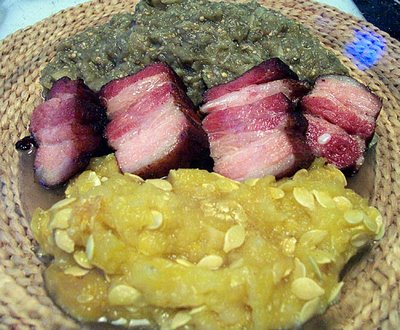 Rillons, a Touraine specialty. It's braised pork breast,
Rillons, a Touraine specialty. It's braised pork breast,
served here with purées of squash and eggplant.
Not only do I not commute any more, but on days when I do go out there's no traffic. Imagine the difference. In San Francisco, I got up early every morning and was on the road by 7:00 a.m. Some days it was stop-and-go for miles and the trip took two hours or even more. One little accident was all it took to bog things down. Other days I would drive at 90 mph for 30 or 40 miles, like a bat out of hell but in heavy traffic on I-280, and I sometimes feared for my life.
For a while, my commute was 52 miles each way, in Bay Area freeway traffic. Then I changed jobs and the commute was only 25 miles each way. The traffic was still bad. At the end, in 2002, my company relocated and I was again driving 80 miles a day just to get to work and back. That's when I said "Basta! Ça suffit. Stop the world, I want to get off!"
Still, cooking daily has been the biggest change in my life. When Walt and I lived in San Francisco, we both went out for at least one meal a day: lunch. For me, it was most often a salad or a sandwich at my desk. Sometimes a group of us from work would go out to a restaurant.
Walt and I made it a habit to go out for dinner at least once a week. For a while, we made the rounds of the Top 100 Restaurants as ranked by the food critic of the San Francisco Chronicle newspaper. That was fun.
For a period of months — it was years ago now — we went to dinner at these restaurants with a woman I had worked with in the late '80s and early '90s. It started when we ran into her by chance one evening in a restaurant in San Francisco. It was 1996 or 1997. She said she was trying to eat in all 100 of the restaurants on the Chronicle list in the space of a year. She often dined alone. We decided to join her as often as we could. Sometimes other friends of ours and hers came with us too.
After that marathon ended (all good things...), W. and I decided it would be a good idea to go out every Friday night to a nice restaurant in the city. What with commuting, work schedules, and busy weekends just getting ready for the next work week, sometimes we felt we hardly ever saw each other except when there were household chores to be taken care of. Friday nights would be time we could spend together doing something we both really enjoyed doing.
We focused on French restaurants, of course, but we also tried good Thai, Japanese, and Mexican places. San Francisco is a great place for food. Some of the restaurants we liked were Le Bistro on Nob Hill, Clémentine on Clement Street, Belon, Le Charm, Plouf, Anjou, plus Jeanty at Jack's, Basil Thai, Regent Thai, The Slanted Door, and many more.
On weekends, I would cook, just because I love to cook. We would have food for several nights as a result of the weekend's cookfests. But by Thursday, usually, we would run out of leftovers, or be tired of eating the same things for several days. So we would order a pizza or some Chinese food. We were lucky to have good takeout restaurants in our San Francisco neighborhood.
Now I cook daily. There aren't any restaurants in Saint-Aignan that deliver. There aren't any Asian restaurants. There is a pizzeria, and you can call and order a pizza, but then you have to go pick it up. The two of us don't go out much, unless we are in Paris. We no longer have the feeling that we hardly ever see each other — au contraire ! We're at home together seven days a week.
So I (or we) cook every day. Well, there's the occasional "day off" when we've made a plat cuisiné like bœuf bourguignon or coq au vin or a tajine d'agneau aux pruneaux the day before. Or a big pot of soup, or a roast of some kind. Then we have leftovers for a few days. And there are days when we eat pâté or rillettes and cheese with bread and wine. Or a salad — but making a salad qualifies as cooking in my book.
One of the reasons I've always enjoyed living in France and one of the main reasons I wanted to come live here is the universal availability of really good, fresh food products. Vegetables, fruit, and meat that you buy in the outdoor markets or at the supermarket are of very high quality. Not to mention the cheese and bread. Or the wine.
I just couldn't imagine where we could live in America, except in an expensive big city like San Francisco, and still get the good food we love. We were tempted by life in the country. So we sold everything and moved to Saint-Aignan.
 Eggplants ready to be roasted. Prick them with a fork or a skewer
Eggplants ready to be roasted. Prick them with a fork or a skewer
to keep them from exploding in the oven.
You might be surprised that I don't list "not working any more" as a huge difference in my life. The fact is, however, that I do still work. I shop. I cook. I garden and do yard work. I clean (in San Francisco we had a house-cleaning crew in twice a month, but not here). I do laundry and hang clothes out to dry. And I blog. So my days are as full as they ever were. It's just that the tasks that fill them up are tasks that I choose to devote my time to.
 Rillons, a Touraine specialty. It's braised pork breast,
Rillons, a Touraine specialty. It's braised pork breast,served here with purées of squash and eggplant.
Not only do I not commute any more, but on days when I do go out there's no traffic. Imagine the difference. In San Francisco, I got up early every morning and was on the road by 7:00 a.m. Some days it was stop-and-go for miles and the trip took two hours or even more. One little accident was all it took to bog things down. Other days I would drive at 90 mph for 30 or 40 miles, like a bat out of hell but in heavy traffic on I-280, and I sometimes feared for my life.
served over rice. On the side, home-made egg rolls.
For a while, my commute was 52 miles each way, in Bay Area freeway traffic. Then I changed jobs and the commute was only 25 miles each way. The traffic was still bad. At the end, in 2002, my company relocated and I was again driving 80 miles a day just to get to work and back. That's when I said "Basta! Ça suffit. Stop the world, I want to get off!"
Still, cooking daily has been the biggest change in my life. When Walt and I lived in San Francisco, we both went out for at least one meal a day: lunch. For me, it was most often a salad or a sandwich at my desk. Sometimes a group of us from work would go out to a restaurant.
Walt and I made it a habit to go out for dinner at least once a week. For a while, we made the rounds of the Top 100 Restaurants as ranked by the food critic of the San Francisco Chronicle newspaper. That was fun.
For a period of months — it was years ago now — we went to dinner at these restaurants with a woman I had worked with in the late '80s and early '90s. It started when we ran into her by chance one evening in a restaurant in San Francisco. It was 1996 or 1997. She said she was trying to eat in all 100 of the restaurants on the Chronicle list in the space of a year. She often dined alone. We decided to join her as often as we could. Sometimes other friends of ours and hers came with us too.
After that marathon ended (all good things...), W. and I decided it would be a good idea to go out every Friday night to a nice restaurant in the city. What with commuting, work schedules, and busy weekends just getting ready for the next work week, sometimes we felt we hardly ever saw each other except when there were household chores to be taken care of. Friday nights would be time we could spend together doing something we both really enjoyed doing.
We focused on French restaurants, of course, but we also tried good Thai, Japanese, and Mexican places. San Francisco is a great place for food. Some of the restaurants we liked were Le Bistro on Nob Hill, Clémentine on Clement Street, Belon, Le Charm, Plouf, Anjou, plus Jeanty at Jack's, Basil Thai, Regent Thai, The Slanted Door, and many more.
On weekends, I would cook, just because I love to cook. We would have food for several nights as a result of the weekend's cookfests. But by Thursday, usually, we would run out of leftovers, or be tired of eating the same things for several days. So we would order a pizza or some Chinese food. We were lucky to have good takeout restaurants in our San Francisco neighborhood.
Now I cook daily. There aren't any restaurants in Saint-Aignan that deliver. There aren't any Asian restaurants. There is a pizzeria, and you can call and order a pizza, but then you have to go pick it up. The two of us don't go out much, unless we are in Paris. We no longer have the feeling that we hardly ever see each other — au contraire ! We're at home together seven days a week.
So I (or we) cook every day. Well, there's the occasional "day off" when we've made a plat cuisiné like bœuf bourguignon or coq au vin or a tajine d'agneau aux pruneaux the day before. Or a big pot of soup, or a roast of some kind. Then we have leftovers for a few days. And there are days when we eat pâté or rillettes and cheese with bread and wine. Or a salad — but making a salad qualifies as cooking in my book.
One of the reasons I've always enjoyed living in France and one of the main reasons I wanted to come live here is the universal availability of really good, fresh food products. Vegetables, fruit, and meat that you buy in the outdoor markets or at the supermarket are of very high quality. Not to mention the cheese and bread. Or the wine.
I just couldn't imagine where we could live in America, except in an expensive big city like San Francisco, and still get the good food we love. We were tempted by life in the country. So we sold everything and moved to Saint-Aignan.
 Eggplants ready to be roasted. Prick them with a fork or a skewer
Eggplants ready to be roasted. Prick them with a fork or a skewerto keep them from exploding in the oven.
23 September 2006
Harvesting the vegetables
All these are fruits, actually — bell peppers, long red peppers, three kinds of squash, and giant cucumbers. I pulled up and composted a lot of plants this morning.
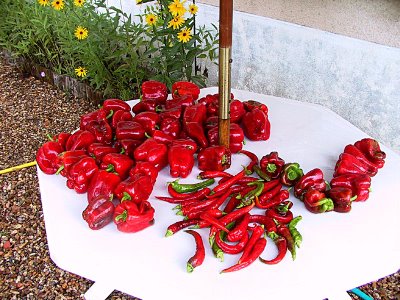 The peppers are good but now I have to prepare them for eating and freezing.
The peppers are good but now I have to prepare them for eating and freezing.
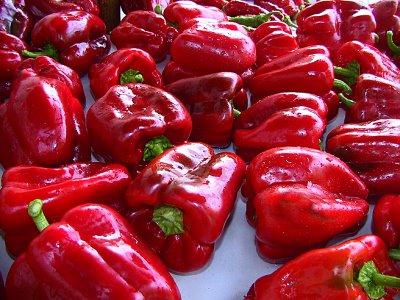 I picked more than 50 red bell peppers before I stopped. I gave some to the neighbors, and I cut up some that had blemishes on them. When I gave six of the nicest red bell peppers to Maryvonne across the street, she said: On dirait des pas vrais, tellement ils sont beaux. They're so pretty that they don't look real.
I picked more than 50 red bell peppers before I stopped. I gave some to the neighbors, and I cut up some that had blemishes on them. When I gave six of the nicest red bell peppers to Maryvonne across the street, she said: On dirait des pas vrais, tellement ils sont beaux. They're so pretty that they don't look real.
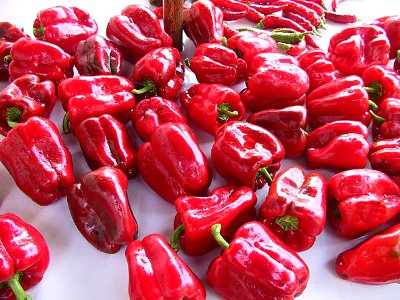 I'll probably make a purée out of the long red peppers and the bell peppers that I trimmed of blemishes and cut into pieces. With some of the others, maybe I'll make some stuffed peppers and chiles rellenos this week.
I'll probably make a purée out of the long red peppers and the bell peppers that I trimmed of blemishes and cut into pieces. With some of the others, maybe I'll make some stuffed peppers and chiles rellenos this week.
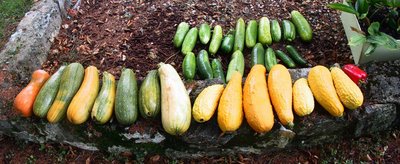 The squash and cucumbers are too enormous to be any good but I wanted a picture of them anyway. Maybe I'll bake the monster zukes and yellow squash. I can discard the skin and seeds and then purée the flesh for the freezer. It'll make good soup over the winter, or an additon to all kinds of soups as a thickener.
The squash and cucumbers are too enormous to be any good but I wanted a picture of them anyway. Maybe I'll bake the monster zukes and yellow squash. I can discard the skin and seeds and then purée the flesh for the freezer. It'll make good soup over the winter, or an additon to all kinds of soups as a thickener.
 Most of our tomatoes have more or less rotted on the vine. It was just too chilly and damp in August. But we got so many tomatoes in late July and early August that the freezer is full of sauce. I'll have to do something about the tomato plants this week. It's supposed to rain for a couple of days now, however...
Most of our tomatoes have more or less rotted on the vine. It was just too chilly and damp in August. But we got so many tomatoes in late July and early August that the freezer is full of sauce. I'll have to do something about the tomato plants this week. It's supposed to rain for a couple of days now, however...
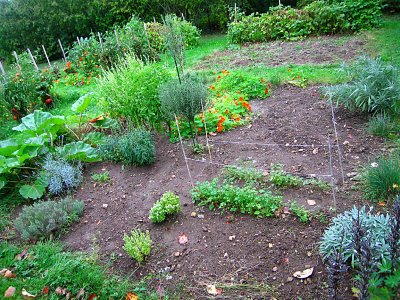 Walt spent some time weeding and cleaning up the herb garden this week, and it really shows. It really is fall now — officially, as of today, and meteorologically as well.
Walt spent some time weeding and cleaning up the herb garden this week, and it really shows. It really is fall now — officially, as of today, and meteorologically as well.
 The peppers are good but now I have to prepare them for eating and freezing.
The peppers are good but now I have to prepare them for eating and freezing. I picked more than 50 red bell peppers before I stopped. I gave some to the neighbors, and I cut up some that had blemishes on them. When I gave six of the nicest red bell peppers to Maryvonne across the street, she said: On dirait des pas vrais, tellement ils sont beaux. They're so pretty that they don't look real.
I picked more than 50 red bell peppers before I stopped. I gave some to the neighbors, and I cut up some that had blemishes on them. When I gave six of the nicest red bell peppers to Maryvonne across the street, she said: On dirait des pas vrais, tellement ils sont beaux. They're so pretty that they don't look real. I'll probably make a purée out of the long red peppers and the bell peppers that I trimmed of blemishes and cut into pieces. With some of the others, maybe I'll make some stuffed peppers and chiles rellenos this week.
I'll probably make a purée out of the long red peppers and the bell peppers that I trimmed of blemishes and cut into pieces. With some of the others, maybe I'll make some stuffed peppers and chiles rellenos this week. The squash and cucumbers are too enormous to be any good but I wanted a picture of them anyway. Maybe I'll bake the monster zukes and yellow squash. I can discard the skin and seeds and then purée the flesh for the freezer. It'll make good soup over the winter, or an additon to all kinds of soups as a thickener.
The squash and cucumbers are too enormous to be any good but I wanted a picture of them anyway. Maybe I'll bake the monster zukes and yellow squash. I can discard the skin and seeds and then purée the flesh for the freezer. It'll make good soup over the winter, or an additon to all kinds of soups as a thickener. Most of our tomatoes have more or less rotted on the vine. It was just too chilly and damp in August. But we got so many tomatoes in late July and early August that the freezer is full of sauce. I'll have to do something about the tomato plants this week. It's supposed to rain for a couple of days now, however...
Most of our tomatoes have more or less rotted on the vine. It was just too chilly and damp in August. But we got so many tomatoes in late July and early August that the freezer is full of sauce. I'll have to do something about the tomato plants this week. It's supposed to rain for a couple of days now, however... Walt spent some time weeding and cleaning up the herb garden this week, and it really shows. It really is fall now — officially, as of today, and meteorologically as well.
Walt spent some time weeding and cleaning up the herb garden this week, and it really shows. It really is fall now — officially, as of today, and meteorologically as well.
22 September 2006
Blois and Vierzon excursions
In topics over the past few days I was describing Saint-Aignan and its Grand Hôtel. Yesterday I looked for some pictures and found this blog entry from a few months ago: Saint-Aignan in Pictures.
Between the adventures Gabby and Margaret had at the laundromat in Saint-Aignan Tuesday morning and our rustic dinner in the village of Thésée that night, we took a nice afternoon drive up to Chambord and Blois. On the way we drove by the château de Chémery, of which I have posted pictures several times before. Here's one:
Tuesday afternoon was nice and sunny. Chambord, one of the major Loire châteaux, was impressive and luminous in the afternoon sunlight. Here's a picture of the enormous Renaissance castle that I took last spring:
After Chambord, we drove down along the Loire toward Blois, through the village of Saint-Dyé and on to a viewpoint where you can see Madame de Pompadour's château called Menars:
At Blois, we parked the car and took in the panorama of the city from the riverfront on the south side of the Loire:
We went up to the cathedral and into the park at the Hôtel de Ville just behind it, to enjoy the views. Here are a couple of previous blog entries with pictures of that part of Blois: A Sunday in Blois and Lunch in Blois.
So it was a nice afternoon and we all enjoyed it, I think. Gabby and Margaret had seen Chambord many years ago, but it's always worth another quick visit. Neither G. nor M. said she could remember ever having been in Blois before, so I'm glad we went.
I already wrote about our dinner in Thésée Tuesday evening.
Wednesday morning, I went to the Grand Hôtel to pick up G. and M. and ferry them over to Vierzon, where they had a rental car waiting for them. They were headed to Burgundy for a few days.
On the way to Vierzon, 35 miles or so east of Saint-Aignan along the Cher, we stopped to see the château and church in the town of Selles-sur-Cher, and then we took a spin through the old walled town of Mennetou. I've posted pictures taken in Selles and Mennetou before.
At Vierzon, the Europcar rental office was located in an Opel car dealership. The woman at the desk processed the rental papers quickly and efficiently. She told me she had had a lot of trouble finding a car with an automatic transmission, but she had been successful: a silver Audi A4 station wagon parked out front was the one. It had arrived just a few minutes before we did.
Here's a picture of our friends in their car, heading out toward Auxerre.
Between the adventures Gabby and Margaret had at the laundromat in Saint-Aignan Tuesday morning and our rustic dinner in the village of Thésée that night, we took a nice afternoon drive up to Chambord and Blois. On the way we drove by the château de Chémery, of which I have posted pictures several times before. Here's one:
Tuesday afternoon was nice and sunny. Chambord, one of the major Loire châteaux, was impressive and luminous in the afternoon sunlight. Here's a picture of the enormous Renaissance castle that I took last spring:
After Chambord, we drove down along the Loire toward Blois, through the village of Saint-Dyé and on to a viewpoint where you can see Madame de Pompadour's château called Menars:
At Blois, we parked the car and took in the panorama of the city from the riverfront on the south side of the Loire:
We went up to the cathedral and into the park at the Hôtel de Ville just behind it, to enjoy the views. Here are a couple of previous blog entries with pictures of that part of Blois: A Sunday in Blois and Lunch in Blois.
So it was a nice afternoon and we all enjoyed it, I think. Gabby and Margaret had seen Chambord many years ago, but it's always worth another quick visit. Neither G. nor M. said she could remember ever having been in Blois before, so I'm glad we went.
I already wrote about our dinner in Thésée Tuesday evening.
Wednesday morning, I went to the Grand Hôtel to pick up G. and M. and ferry them over to Vierzon, where they had a rental car waiting for them. They were headed to Burgundy for a few days.
On the way to Vierzon, 35 miles or so east of Saint-Aignan along the Cher, we stopped to see the château and church in the town of Selles-sur-Cher, and then we took a spin through the old walled town of Mennetou. I've posted pictures taken in Selles and Mennetou before.
At Vierzon, the Europcar rental office was located in an Opel car dealership. The woman at the desk processed the rental papers quickly and efficiently. She told me she had had a lot of trouble finding a car with an automatic transmission, but she had been successful: a silver Audi A4 station wagon parked out front was the one. It had arrived just a few minutes before we did.
Here's a picture of our friends in their car, heading out toward Auxerre.
Subscribe to:
Posts (Atom)






